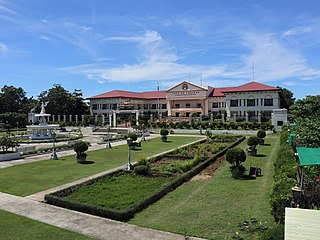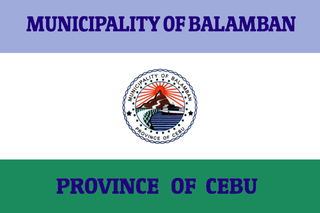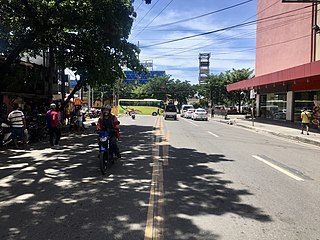
Cebu City, officially the City of Cebu, is a 1st class highly urbanized city in the Central Visayas region of the Philippines. It is the capital of the Cebu Province, where it is geographically located but is one of three cities that are administratively independent of the provincial government. According to the 2020 census, it has a population of 964,169 people, making it the sixth-most populated city in the nation and the most populous in the Visayas.

Talisay, officially the City of Talisay, is a 3rd class component city in the province of Cebu, Philippines. According to the 2020 census, it has a population of 263,048 people.

Tandag, officially the City of Tandag, is a 5th class component city and capital of the province of Surigao del Sur, Philippines. According to the 2020 census, it has a population of 62,669 people.

Balamban, officially the Municipality of Balamban, is a 1st class municipality in the province of Cebu, Philippines. According to the 2020 census, it has a population of 95,136 people.

Malabuyoc, officially the Municipality of Malabuyoc, is a 5th class municipality in the province of Cebu, Philippines. According to the 2020 census, it has a population of 19,770 people. Malabuyoc is situated in the southwestern coast of the island of Cebu and is 139 kilometres (86 mi) from Cebu City.
Uldarico Aguilar Alviola Sr. was a Filipino Visayan civil servant, novelist, and editor from Cebu, Philippines. While he wrote in English and Spanish, his published works in Cebuano language earned him the title, "Dean of Cebuano Writers."
Wenceslao "Ben" Zubiri, who was also known as Iyo Karpo was a Cebuano composer, actor, and media personality in the Philippines. His most famous composition, for which he wrote both the lyrics and music, is the song Matud Nila.

Don Vicente Rama Memorial National High School is a public secondary school in Cebu City in the Philippines.
The legislative districts of Cebu City are the representations of the highly urbanized city of Cebu in the various national legislatures of the Philippines. The city is currently represented in the lower house of the Congress of the Philippines through its first and second congressional districts.

DYHPRMN Cebu is a radio station owned and operated by the Radio Mindanao Network. Its studios and offices are located at the RMN Broadcast Center, G/F Capitol Central Hotel and Suites, N. Escario St., cor. F. Ramos Ext., Capitol Site, Cebu City and at RMN Drama Production Center, Room 302, 3/F Jose R. Martinez Bldg., Osmeña Blvd., Cebu City; while its transmitter facilities are located along DYHP-IFM Transmitter Site, Sitio Seaside Asinan, Brgy. Basak San Nicolas, Cebu City. DYHP is the pioneer AM radio station in Cebu.

The South Road Properties (SRP), also known as the South Reclamation Project, is a 300 ha reclamation area in Cebu City, Philippines. The area, which is reclaimed from Mactan Channel, is located off the coast of the southern district of Cebu City, near Barangays Mambaling, Inayawan, and Pasil. It spans from the shore of mainland Cebu to Kawit Point. An island-type reclaimed area, it is connected with mainland Cebu by the Cebu South Coastal Road and the Mambaling Access Road. Through the Cebu–Cordova Link Expressway, the SRP is also connected by land to Cordova and the island of Mactan.
Vicente Hermosa Garces, also known as Vicente Garces and Nyor Inting, was a Filipino Visayan politician, writer, and poet. His famous written works in Cebuano were published in Visayan newspaper, Bag-ong Kusog. He also served as mayor in the then municipality of Talisay, Cebu, Philippines from 1925 to 1937.

Vicente Rama was a Filipino Visayan legislator, publisher, and writer from Cebu, Philippines. Recognized as the Father of Cebu City, he authored the bill for its cityhood which was approved into law by October 20, 1936. He also founded the leading pre-war Cebuano periodical, Bag-ong Kusog.
Nicolas Mercado Rafols Jr. was a Filipino Visayan legislator, journalist, businessman, lawyer, and agriculturalist from Cebu, Philippines. He was a member of the House of Representatives for Cebu's 6th District for multiple terms.
Hilario "Dodong" Abellana y Hermosa was Filipino Visayan lawyer, politician and legislator from Cebu, Philippines. He was the municipal president of Cebu (1922–1931), a member of the House of Representatives (1934–1935), a two-term member of the National Assembly (1935–1941), and porvincial governor of Cebu during World War II (1941–1943). After his escape and eventual captivity, he was executed by the Japanese Imperial Army and the resting place of his remains is still unknown.
Jose S. Leyson (1900–1945) was a Filipino Visayan lawyer and politician from Cebu, Philippines. He was appointed by the Japanese forces to serve as governor of the province of Cebu during World War II. His death occurred before the end of the World War II, and the whereabouts of his remains are unknown.
Tres de Abril Street is a national tertiary road in Cebu City, Cebu, Philippines. It commences at Spolarium Street in Barangay Pasil which connects Barangay Ermita through the Forbes Bridge, passes through the junctions of C. Padilla Street and N. Bacalso Avenue, and ends at the junction of F. Llamas Street in Barangay Punta Princesa. It was formerly considered as a national secondary road under Executive Order No. 113 issued by President Ramon Magsaysay on May 2, 1955.

F. Llamas Street is a national tertiary road in Cebu City, Cebu, Philippines. It commences at N. Bacalso Avenue in Barangay Basak San Nicolas, passes through the junction of Tres de Abril and E. Sabellano streets and ends at the junction of Katipunan Street in Barangay Tisa. It was formerly considered as a "national aid" city road under Executive Order No. 113 issued by President Ramon Magsaysay on May 2, 1955.
Katipunan Street is a national tertiary road in Cebu City, Cebu, Philippines. It commences at the corner of N. Bacalso Avenue and V. Rama Avenue in Barangay Calamba, passes through the junctions of A. Lopez and Salvador streets and ends at the junction of F. Llamas Street in Barangay Tisa.









